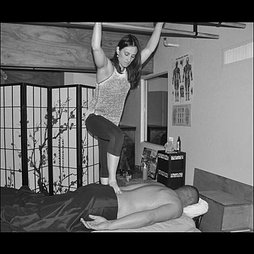
Ashiatsu Massage is the “walking on the back” massage, explained
by Lauren Potter
Ashiatsu massage – a little known, yet very powerful massage therapy technique dating back 2,000 years – features the massage therapist using his or her feet instead of hands.
That’s right – their feet.
In fact, the Japanese word itself means exactly what it is – ashi (foot), atsu (pressure).
The technique offers a safe and effective alternative that often provides more efficient “deep, gliding, gravity-assisted compressive strokes” to conduct the massage.
Deep tissue massages like ashiatsu manipulate the circulatory system and create an increase in blood flow and thus oxygen flow to promote healing throughout the body.
Through broad and lengthening movements, ashiatsu massage softens the musculature, bringing the skeletal structure back into alignment just like any good massage – but it is done with the feet!
“So, you’re going to walk on my back?”
It seems a little crazy to think someone is going to walk on your back and it’s going to feel good, but trust us, it’s fantastic – and not as crazy as you think.
In fact, like massage therapy in general, the ashiatsu technique is an ancient practice deeply rooted in Eastern medicine that is really just another way to do deep tissue work on areas of chronic pain or muscle tension.
It just highlights the use of feet instead of hands to apply even, gentle and deep pressure to muscles in the body.
“OK, sounds good – but how does a therapist actually do this?”
Don’t worry, it’s not a circus act during your massage, but there are some apparatuses used by most therapists doing this technique to make sure it is easy for them and safe for their clients.
While you may initially be anxious about allowing a therapist to use his or her bodyweight, the practice is perfectly safe.
Through poles attached to the ceiling or support rails placed on the floor, massage therapists are able to distribute their weight and put as much or little pressure as they like on their clients.
The use of feet allows for steady and controlled movement, which differs from the usual intense strokes featured in regular deep tissue massage.
During ashiatsu, a heavier but still gentle pressure is applied because the massage pressure is spread out through the feet.
Ashiatsu massage capitalizes on body weight and physics to create the “deepest pressure that a massage therapist can safely give.”
“I like it…but how do I know if I should get an ashiatsu massage?”
Ashiatsu massage is ideal for patients who require regular deep tissue massage to large muscle groups – such as those in the back and glutes.
Because the wide surface of the foot allows for pressure to be evenly distributed while gliding across the muscles, the technique offers a stronger, controlled application of pressure.
Using bodyweight to their advantage, massage therapists are able to apply the necessary pressure to more effectively deal with chronic pain issues that rest deep in the soft tissues.
And since the bodyweight technique for applying pressure can help a therapist more easily knead trigger points and get at chronic pain in larger and/or more dense muscle groups, ashiatsu massage often provides a better deep tissue experience because the strength and leverage required in these areas often cannot be matched using only hands.
As a bonus, this method of massage also helps preserve the longevity of massage therapists because of their increased ability to effectively provide deep tissue massage without overexerting and injuring their hands and arms. And we always want to preserve our beloved massage therapists!
Want to try it for yourself? The easiest way we know of to find experienced providers of Ashiatsu massage is on the MassageBook directory of massage therapists.
If you’re interested in becoming a certified Ashiatsu massage provider, you can learn more about training and education from Ashiatsu.net and thebarefootmasters.com.






Thanks for the great resource, Lauren!